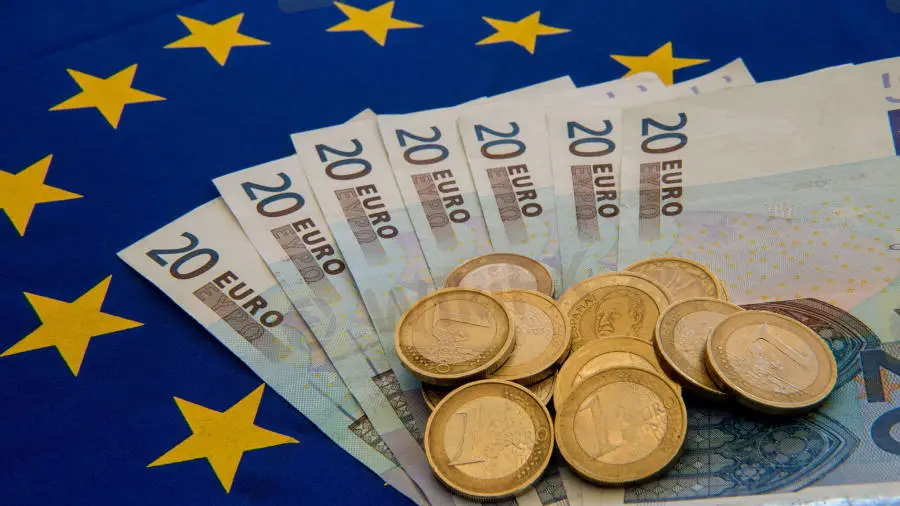简体中文
繁體中文
English
Pусский
日本語
ภาษาไทย
Tiếng Việt
Bahasa Indonesia
Español
हिन्दी
Filippiiniläinen
Français
Deutsch
Português
Türkçe
한국어
العربية
Euro set for biggest monthly drop since mid-2019 on economy fears
Abstract:Euro set for biggest monthly drop since mid-2019 on economy fears

The euro languished below $1.18 on Monday as the prospect of tougher coronavirus curbs in France and Germany weighed on the short-term outlook for the European economy.
The common currency is headed for its biggest monthly drop since mid-2019 as Europe's faltering vaccination programme runs into a wave of new infections even as positioning data showed investors remain heavily long euros. and
The euro was down 0.1% in early London trading at $1.1774, not far above last week's four-and-a-half-month trough of $1.1762. On a monthly basis, it is down 2.3%, its biggest fall since July 2019.
Compounding the single's currency woes has been the widening interest rate differentials between German and U.S. yields with the spread between 10-year debt widening to 200 bps from 150 bps at the start of the year, boosting the greenback.
“Much focus will remain on the virus situation in Europe and whether lockdowns can slow rising case numbers and also whether the slow pace of vaccinations can finally reach exit speed,” ING economists said in a daily note.
The dollar held firm broadly against its rivals as a slight risk-off sentiment rippled through global markets with U.S. stock futures in negative territory in quiet quarter-end rebalancing flows.
Against a basket of its rivals, the dollar steadied at 92.810, just below a November 2020 high of 92.92 hit last week.
Weekly positioning data showed the broad trend of growing dollar bullishness remained firmly in play with hedge funds cutting their overall short dollar bets to their lowest levels since June 2020 while ramping up their bearish bets on the yen.
Virus-driven caution also helped the dollar higher against the Australian dollar, New Zealand dollar and sterling and it rose against oil-liked currencies as the re-floating of the ship blocking the Suez Canal pushed crude prices down by about 1.5%.
The Aussie was last down 0.3% at $0.7621 on Monday and the New Zealand dollar had dropped 0.3% to $0.6978, while sterling GBP= slipped 0.2% to $1.3767.
“The U.S. is also being helped on its own by some pretty good economic data, fantastic rollouts of vaccines, good pace of vaccination and (positive) stock markets,” said Westpac currency analyst Imre Speizer.
----------------
WikiFX, the world's No.1 broker inquiry platform!
Use WikiFX to get free trading strategies, scam alerts, and experts experience!
Android : cutt.ly/Bkn0jKJ
iOS : cutt.ly/ekn0yOC

Disclaimer:
The views in this article only represent the author's personal views, and do not constitute investment advice on this platform. This platform does not guarantee the accuracy, completeness and timeliness of the information in the article, and will not be liable for any loss caused by the use of or reliance on the information in the article.
Read more

The Threat Of A Summer Lull For The Euro And Stocks
The Threat Of A Summer Lull For The Euro And Stocks
Is The Euro Dying?
Is The Euro Dying?

Divergence of Britain and EU Is Weighing Down on Euro
When it comes to the future of European capital market after Brexit, Britain and the European Union had not seen great disputes as they did over other issues. But the situation is changing now.

Declining EUR/USD: What’s the Pivot Point?
The euro has been in a declining trend recently, falling against US dollar for 8 consecutive trading days since January 31st , 2020. Technically, the euro may be slightly oversold, and 1.0880 is a key support level for EUR/USD.
WikiFX Broker
Latest News
Saxo & Portuguese Bank Partnership
SEC Fines Broker-Dealers $275K for Incomplete SAR Filings
Elon Musk Warns of Imminent US Bankruptcy | Bitcoin Retreats from $100K
UK FCA Fines Barclays £40 Million Over 2008 Deal
WikiEXPO Global Expert Interview: Advanced Practices and Insights in Financial Regulation
Justin Sun Invests $30M in Trump-Backed World Liberty Financial
Lured by False Promises: Malaysian Driver Lost RM218K to an Investment Scam
FTX Sets March 2025 Timeline for Creditor Payouts: What It Means for Investors
What is an Economic Calendar? How it works
Pros & Cons of Automated Forex Trading
Currency Calculator


